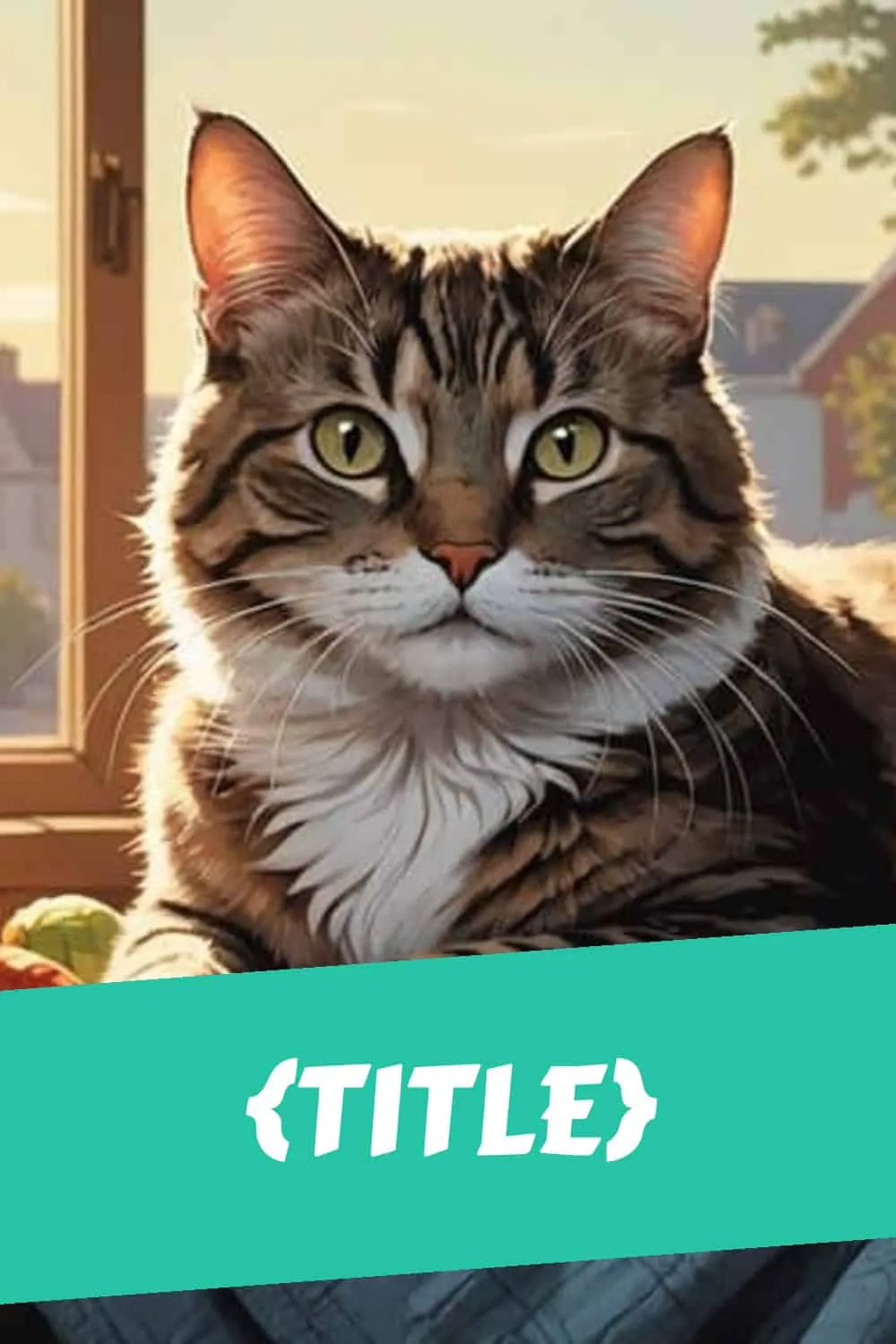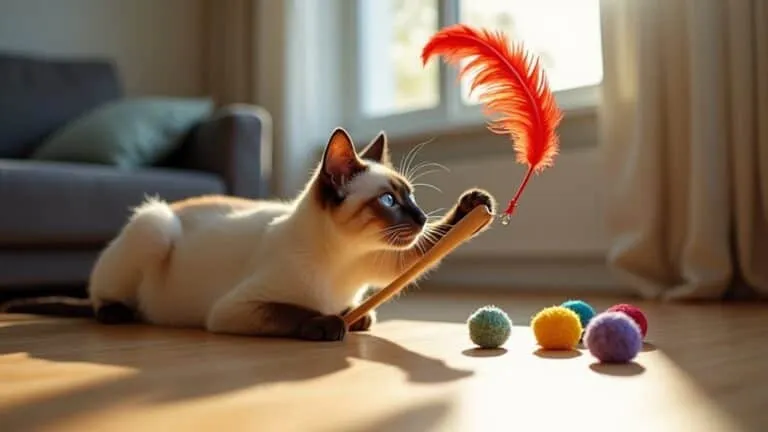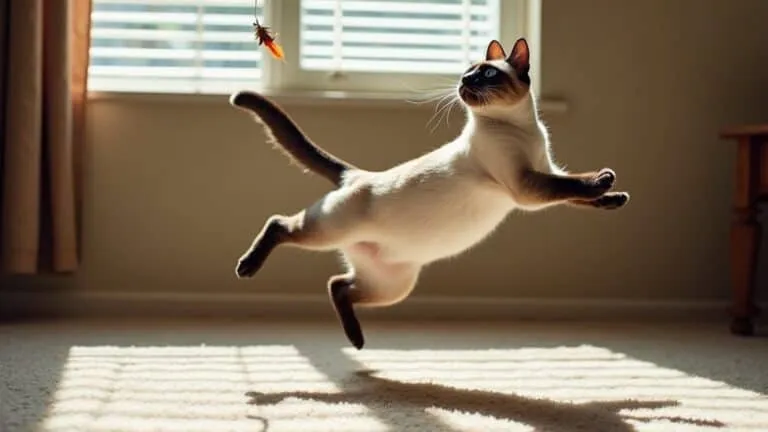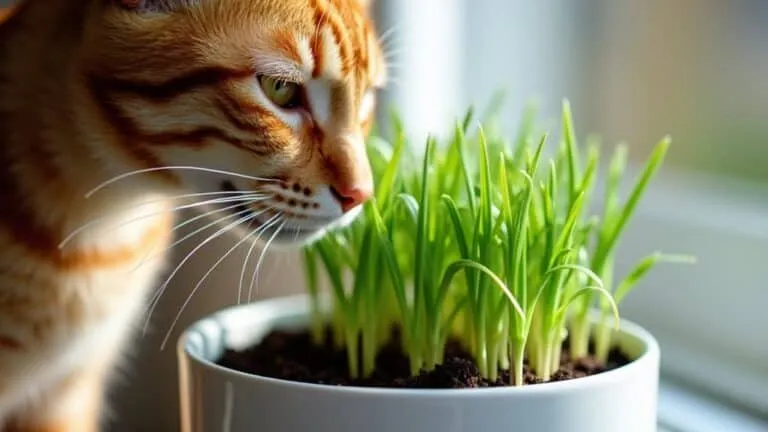The Best Fluffy Pancakes recipe you will fall in love with. Full of tips and tricks to help you make the best pancakes.

Understanding cat whisker fatigue is essential for your feline’s comfort. This condition arises from sensory overload when whiskers touch deep or narrow bowls, leading to irritation and stress. Symptoms include reluctance to eat, messy feeding habits, and increased agitation. To prevent whisker fatigue, opt for shallow, wide bowls that allow whiskers to move freely. Regularly monitor their feeding environment, as clutter can exacerbate the issue. By ensuring a comfortable setup and recognizing the signs of distress, you can enhance your cat’s well-being. There’s more to explore on how to create the ideal feeding conditions for your furry friend.
What Is Whisker Fatigue?
Whisker fatigue, or whisker stress, is a condition many cat owners mightn’t be aware of, yet it can greatly impact your feline friend’s well-being. This issue arises when your cat’s sensitive whiskers experience sensory overload from frequent contact with objects, primarily deep food and water bowls.
While it’s not classified as an illness, the discomfort it causes can lead to anxiety and stress for your pet.
You might notice symptoms of whisker fatigue in your cat, such as reluctance to eat from bowls, pawing food out to eat from the floor, or showing signs of agitation and withdrawal.
These behaviors indicate that your cat is uncomfortable and overwhelmed by the stimulation their whiskers are receiving.
To prevent whisker fatigue, consider providing shallow, wide bowls that allow your cat to eat and drink without the distress of excessive whisker contact.
By making this simple adjustment, you can considerably enhance your cat’s eating experience and overall comfort.
Causes of Whisker Fatigue
Cats experience whisker fatigue primarily due to the repeated contact of their sensitive whiskers with the sides of deep food and water bowls. This overstimulation of tactile receptors can lead to discomfort during eating or drinking.
Whiskers serve an essential function, helping cats sense their environment, but when they constantly brush against surfaces, it can result in sensory overload. Long whiskers on cats explained their importance not just in navigation but also in building their confidence. These specialized hairs, being highly sensitive, can detect even the slightest changes in air currents, allowing cats to assess their surroundings. However, when they are overstimulated by constant contact with objects, it can lead to stress and anxiety, making it crucial for owners to create a comfortable environment for their feline friends. In such cases, cats may exhibit signs of stress or anxiety, leading them to seek out quieter spaces. Understanding cats’ whiskers and their functions reveals how crucial they are to a cat’s navigation and communication. By providing a calm environment, owners can help reduce sensory overload and ensure their feline friends lead comfortable lives.
Several causes contribute to whisker fatigue:
- Deep or narrow food bowls: These can restrict whisker movement, causing irritation.
- Environmental clutter: A messy space can add to your cat’s stress, exacerbating discomfort.
- Individual sensitivity: Some cats are naturally more prone to whisker fatigue than others.
- Repeated interactions: Everyday encounters with various objects can accumulate stress over time.
Understanding these causes allows you to better support your feline friend.
Symptoms to Watch For

When observing your feline companion, it’s crucial to recognize the symptoms of whisker fatigue, as they can greatly impact their well-being. Whisker fatigue in cats can manifest in various ways, including sensitivity when eating from deep dishes, irritability, or a reluctance to engage in feeding altogether. It’s essential to provide shallow food and water bowls to minimize this stress and ensure that your cat feels comfortable during mealtime. By paying attention to these signs, you can help alleviate their discomfort and promote a happier, healthier lifestyle.
One common sign is a reluctance to eat or drink from their food bowls, often leading them to paw food out and consume it off the floor. This behavior can indicate discomfort related to whisker contact with the bowl’s sides.
You might also notice your cat displaying signs of anxiety when approaching their food or water bowls. They may pace or hesitate before eating, reflecting their distress during mealtime.
Additionally, messy eating habits, such as spilling food or knocking contents onto the floor, can further signal discomfort associated with whisker fatigue.
Some cats might leave food uneaten in their bowls despite appearing hungry, which is another troubling symptom.
Finally, if your cat shows aggressive behavior towards other pets or humans during feeding times, it could reflect stress linked to this condition.
Impact on Cat Behavior
Recognizing the symptoms of whisker fatigue can greatly alter how you observe and interact with your feline friend. When cats experience whisker fatigue, their behavior can change markedly, often leading to confusion and frustration during mealtime.
You might notice some of the following behavioral indicators:
- Pacing in front of food and water bowls, appearing hungry yet refusing to eat from deep bowls.
- Pawing food out of bowls to eat off the floor, indicating discomfort from whisker contact with the bowl sides.
- Increased agitation or even aggression towards other pets or humans during meals as your cat tries to avoid stress.
- Reduced interaction with you or other pets, as your cat withdraws due to sensory overload.
These changes in behavior highlight the importance of recognizing whisker fatigue. By understanding how this condition impacts your cat, you can help cats by adjusting their feeding setup, ensuring they feel comfortable and secure.
Observing these behaviors closely can also prevent misinterpretation of whisker fatigue as other health issues, allowing for timely intervention.
Prevention Strategies

To prevent whisker fatigue, you should choose wide, shallow bowls that let your cat eat and drink comfortably.
Consider using flat feeding surfaces like plates or saucers to further reduce whisker strain.

Shallow Bowl Recommendations
Choosing the right food and water bowls for your cat is essential in preventing whisker fatigue, as shallow, wide designs minimize whisker contact.
Cats’ whisker sensitivity can lead to discomfort during feeding, but with the proper bowl choice, you can create a more pleasant mealtime experience.
When selecting shallow bowls, consider the following recommendations:
- Low-profile design: Guarantee the bowl has a low height to prevent whiskers from touching the sides.
- Wide diameter: Opt for wide food bowls that allow cats to eat comfortably without whisker interference.
- Material matters: Stainless steel bowls are durable, easy to clean, and resistant to bacteria, promoting a hygienic feeding environment.
- Whisker-friendly options: Look for bowls specifically designed for whisker sensitivity, like those offered by Americat Company, which cater to your cat’s needs.
Environmental Adjustments
Creating a comfortable environment for your cat is vital in preventing whisker fatigue. One effective strategy is to utilize shallow, wide bowls for food and water. These adjustments minimize whisker contact with bowl sides, reducing discomfort during meals.
Consider offering flat surfaces, such as plates or wide saucers, instead of traditional deep bowls; this can greatly alleviate symptoms associated with whisker fatigue.
Additionally, maintaining a spacious living area with minimal clutter can help your cat avoid constant whisker stimulation. This allows for unrestricted movement, further promoting comfort.
Implementing water fountains is another beneficial environmental adjustment. Fountains encourage hydration while preventing whisker stress from bowl contact, catering to your cat’s sensitivity.
It’s important to regularly monitor your cat’s behavior and adjust their feeding environments based on their reactions.
Recommended Feeding Solutions
Many cat owners overlook the importance of feeding solutions that accommodate their pet’s whisker sensitivity. To guarantee your cat eats comfortably and enjoys their meals, consider the following recommendations:
- Use shallow, wide bowls to minimize whisker contact. Deep bowls can irritate sensitive whiskers, making mealtime unpleasant.
- Opt for stainless steel bowls, which resist bacteria and are easy to clean, enhancing your cat’s overall hygiene and health.
- Consider cat water fountains that provide flowing water. This encourages drinking and helps reduce the risk of whisker fatigue associated with static water bowls.
- Serve food on flat surfaces like plates or saucers. This allows your cat to eat comfortably without whisker interference.
It’s essential to monitor your cat’s eating behavior regularly. If you notice signs of discomfort or hesitation while eating, it may be time to adjust their feeding equipment.
By implementing these feeding solutions, you can help alleviate whisker fatigue, guaranteeing your cat enjoys mealtime and maintains a healthy lifestyle.
Prioritizing their comfort shows your commitment to their well-being, allowing for a happier, healthier feline companion.
When to Consult a Veterinarian
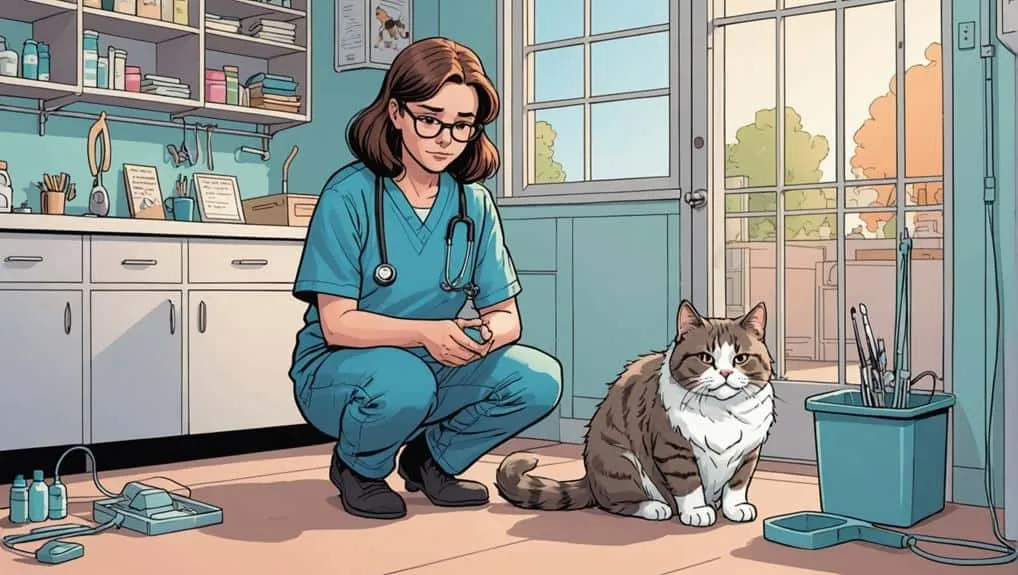
Recognizing the signs of whisker fatigue is important, but understanding when to seek veterinary advice can make a significant difference in your cat’s well-being. If you notice persistent behavioral changes such as reluctance to eat or drink, pacing, or aggressive behavior, it’s vital to consult a veterinarian. These behaviors may indicate not only whisker fatigue but also potential underlying health issues that require professional evaluation.
Regular veterinary visits are necessary for monitoring your cat’s overall health. A veterinarian can provide a thorough assessment to confirm a diagnosis of whisker fatigue, as symptoms can often mimic dental disease or other gastrointestinal disorders.
Keeping a detailed record of any behavioral changes will help your veterinarian tailor their approach to your cat’s specific needs. Don’t hesitate to seek advice. Veterinarians can recommend modifications to your cat’s environment and feeding practices to alleviate whisker stress effectively.
Addressing these concerns early guarantees your cat receives the appropriate care and support for a healthier, happier life. Remember, proactive measures can lead to significant improvements in your cat’s well-being.
Long-Term Care Tips
To guarantee your cat’s comfort and well-being, it’s vital to monitor their eating habits closely.
Providing a comfortable feeding environment with shallow, wide bowls can greatly reduce whisker fatigue.
Regular veterinary check-ups will help you evaluate their health and receive tailored advice for ongoing care.
Monitor Eating Habits
Monitoring your cat’s eating habits is essential for their overall health and well-being. By observing their behavior, you can identify signs of whisker fatigue or other potential health issues. Pay attention to any sudden changes in appetite or reluctance to eat, as these could indicate discomfort.
To create a supportive feeding environment, consider these tips:
- Establish multiple feeding stations: This helps accommodate your cat’s preferences and minimizes stress during mealtime.
- Use shallow, wide bowls: These reduce whisker contact, enhancing comfort and encouraging healthy eating patterns.
- Maintain a consistent feeding schedule: Regularity helps prevent anxiety, which can negatively affect your cat’s appetite.
- Monitor the feeding area for mess: Excessive spills might signal discomfort, indicating a need for a different bowl or setup.
Taking these steps not only improves your cat’s comfort but also contributes to their overall health. By actively engaging in monitoring eating habits, you’re prioritizing their well-being and setting the foundation for a happier, healthier life.
Comfortable Feeding Environment
Creating a comfortable feeding environment is essential in preventing whisker fatigue and promoting your cat’s overall health. To achieve this, consider using shallow, wide food and water bowls. These designs greatly reduce whisker contact, minimizing the risk of discomfort during mealtime.
Opt for stainless steel bowls, as they’re easy to clean, resist bacteria, and don’t retain odors, ensuring a healthier eating space for your cat. Additionally, flat feeding surfaces like plates or saucers can serve as effective alternatives to traditional bowls, providing a more comfortable experience and further preventing whisker irritation.
Your cat’s feeding area should also be quiet and spacious, allowing them to eat without distractions or competition. Regularly evaluating and adjusting your cat’s feeding environment can lead to improved eating habits and overall well-being.
Regular Veterinary Checkups
Regular veterinary checkups play an essential role in maintaining your cat’s health and can help identify issues that may mimic whisker fatigue. These visits not only allow for early detection of potential health-related issues, such as dental disease or gastrointestinal disorders, but they also provide an opportunity to discuss your cat’s behavior changes and eating habits.
To guarantee your cat’s well-being and effectively manage whisker fatigue, consider the following tips during your veterinary checkups:
- Discuss any noticeable behavior changes with your veterinarian.
- Monitor your cat’s eating habits and be open about any concerns.
- Ask for recommendations on appropriate feeding bowls that reduce whisker strain.
- Inquire about environmental adjustments to alleviate symptoms of whisker fatigue.
Maintaining a routine schedule for veterinary care helps you monitor your cat’s overall health. This proactive approach enables you to promptly address any emerging concerns, including whisker fatigue.
Understanding Whisker Sensitivity
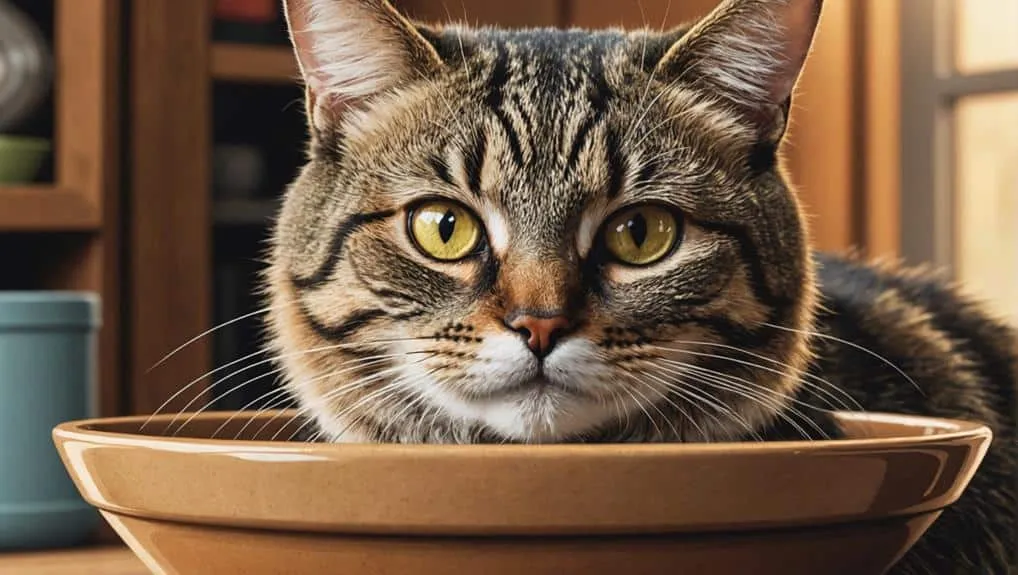
Understanding whisker sensitivity is fundamental for appreciating how cats interact with their environment. Your cat’s whiskers, known as tactile hairs or vibrissae, are critical sensory organs that help them navigate and understand their surroundings. These sensitive hairs are embedded deeply in the skin and packed with nerve endings, allowing your cat to detect spatial relationships and even minor air currents.
Overstimulation of these whiskers can lead to whisker fatigue, causing discomfort and behavioral changes. To help you better understand this phenomenon, here’s a quick reference table:
| Aspect | Description |
|---|---|
| Tactile Hairs | Highly sensitive, help detect surroundings |
| Spatial Relationships | Aid in evaluating whether they can fit through spaces |
| Sensory Organs | Provide essential information about nearby objects |
| Overstimulation | Can lead to whisker fatigue and stress |
| Prevention Strategies | Use wide, shallow bowls to prevent whisker discomfort |
Recognizing the signs of whisker fatigue can help you prevent whisker-related distress. By ensuring your cat’s environment is accommodating, you can promote their well-being and enhance their quality of life.
Frequently Asked Questions
How to Prevent Whisker Fatigue in Cats?
To prevent whisker fatigue, choose whisker friendly dishes that promote stress free feeding. Observe your cat’s feeding habits, providing comfortable environments and alternative food options, ensuring their dining experience is free from sensory overload and discomfort.
How to Prevent Whisker Fatigue in Cats?
To prevent whisker fatigue, you should choose shallow feeding dishes and monitor your cat’s nutrition. Incorporate enrichment activities and reduce stress through a calm environment, considering your cat’s whisker sensitivity and overall feline behavior.
How Serious Is Whisker Fatigue?
Whisker fatigue can lead to cat stress, impacting whisker health and feline comfort. Sensory overload from feeding habits and environmental factors may exacerbate discomfort, so it’s crucial to monitor your cat’s behavior for signs of distress.
How Serious Is Whisker Fatigue?
Whisker fatigue can be serious, affecting feline behavior and causing feeding challenges. You might notice stress indicators, which can lead to health implications. Environmental factors play an essential role in managing your cat’s comfort and wellbeing.
Final Thoughts
Ultimately, whisker fatigue is a real concern for many cats, affecting their comfort and behavior. By recognizing the causes and symptoms, you can take proactive steps to prevent this issue. Implementing recommended feeding solutions and being mindful of your cat’s needs will enhance their well-being. If you notice persistent signs of discomfort, don’t hesitate to consult your veterinarian for guidance. Your awareness and care can make a significant difference in your cat’s quality of life.

